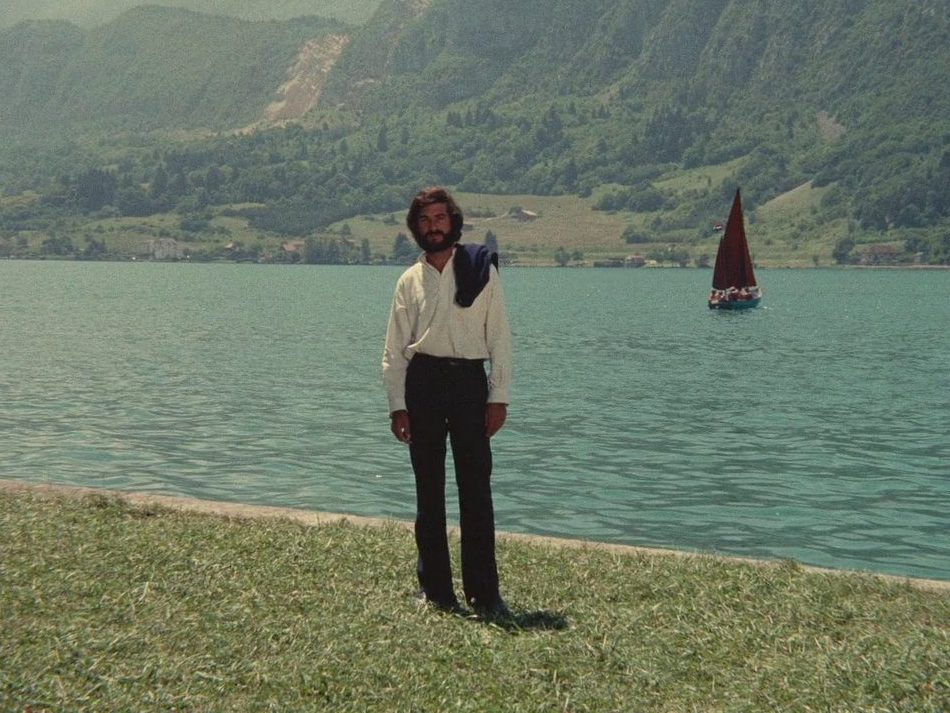
“Why would I tie myself to one woman?” asks Jerôme in Le Genou de Claire, though he plans to marry a diplomat’s daughter by summer’s end. He spends his July at a lakeside boardinghouse, nursing crushes on the sixteen-year-old Laura and, more tantalizingly, her long-legged, blonde, older half sister, Claire. Baring her knee on a ladder under a blooming cherry tree, Claire unwittingly incites a moral crisis for Jerôme while creating an image that is both the iconic emblem of Eric Rohmer’s Six Moral Tales and one of French cinema’s most enduring moments.
“Graham Petrie: In Maud and Le Genou de Claire in particular you show us some people around thirty-five to forty years old and also some who are very much younger. Do you think there is now a real disparity between these age groups, in the way that people often talk of the new generation having a completely different set of customs and moral values?
Eric Rohmer: My films are pure works of fiction, I don’t claim to be a sociologist, and I’m not making investigations or collecting statistics. I simply take particular cases that I have invented myself, they aren’t meant to be scientific, and they are works of imagination. Personally, I’ve never believed very much in the idea of a difference between age groups, I don’t think it’s very strong and it’s certainly not an opposition between one group and another, and I don’t thinks it’s so very much stronger nowadays than it was before. And even if it is true, it doesn’t interest me very much. It’s not something I’m concerned with. The fact that the young generation today in 1971 might as a whole have a certain kind of mentality doesn’t interest me. What interests me is to show young people as they really are just now, but also as they might be if they were fifty years old or a hundred years old, and the events of the film could have taken place in Ancient Greece, for things haven’t changed all that much. For me what is interesting in mankind is what is permanent and eternal and doesn’t change, rather than what changes, and that’s what I'm interested in showing.”
Eric Rohmer in conversation with Graham Petrie1
“Of all the (mostly European, or non-American) directors truly interested in women—that is, who put them repeatedly at the center of their work—none has been so fascinated by the spectrum of womankind, and girlkind (a separate breed in Rohmer, and rightly so), and examined our sex with such a fine mixture of dispassion and empathy. Other directors—indeed, male artists in general—when free to express their own sensibilities, almost can’t help foisting their neuroses onto women: they give us femmes fatales who bear the burden of male sexual guilt, pathetic victims whose humiliation provides a salve to the male ego or a target for his rage, idealizations whose beauty confirms their discoverers’ own good taste. But Rohmer goes deeper, examining and gently mocking those very processes, the unconscious strategies by which men use women for their own practical, moral, and artistic purposes.”
Molly Haskell2
“Photos of the shoot show us a Rohmer who is tense, concentrated, obsessed with the countless details of making his film. But all around him, the atmosphere was that of a summer camp, where everyone yielded good-humoredly to the demands of this rather mad big brother, because Rohmer had the brilliant idea of surrounding himself solely with young people. Fabrice Luchini, for instance, an apprentice actor (and former hairdresser) whom Rohmer discovered in a small role in one of Philippe Labro’s films, and who impressed him from the first time they met by reciting Nietzsche to him. He was twenty years old, crackling with intelligence and humor, and he made the whole Claire’s Knee group laugh until they cried by imitating Rohmer or by developing one of the far-fetched theories that were his specialty—to the point that Rohmer let him improvise his own text in front of the camera, reducing Brialy to the role of a dumbfounded listener. There was also Gérard Falconetti, the grandson of the actress in Dreyer’s film The Passion of Joan of Arc, whose impeccable physique was displayed in a swimsuit on the lakeshore. His insolence immediately seduced the filmmaker: it was precisely the insolence of Gilles, Claire’s arrogant fiancé, responding haughtily to the plebeian campers who dared to walk on his flowerbeds. That sequence was also improvised, as if Rohmer were trying, with each of his young actors, to blur as much as possible the boundaries between reality and fiction.”
Antoine de Baecque3
- 1Graham Petrie, "Eric Rohmer: An Interview", Film Quarterly 24, no. 4 (Summer 1971): 34–41.
- 2Molly Haskell, “Claire’s Knee: Rohmer’s Women”, Criterion, August 14 2006.
- 3Antoine de Baecque, 'Éric Rohmer', (Apple Books?), p.254.